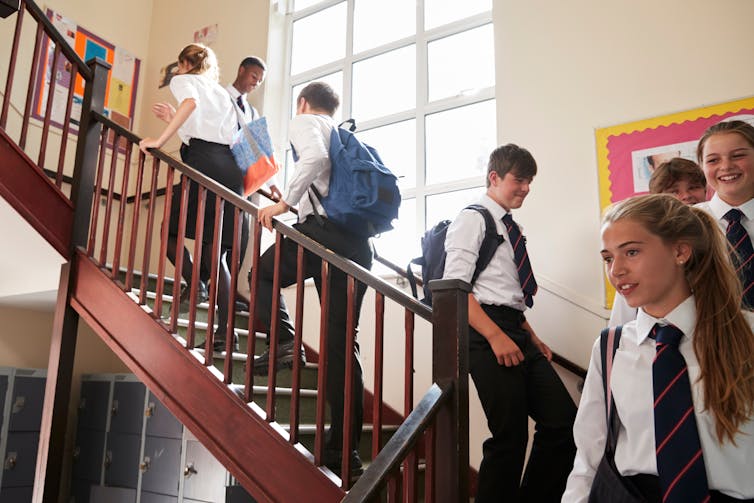In September 2022, schools in England were at risk of bankruptcy as their day-to-day spending threatened to overtake their regular income. A hasty autumn budget included additional revenue funds for schools, coming as a relief to many school leaders.
Twelve months later the chancellor, Jeremy Hunt, is under pressure to dig deep into his coffers again. This time, schools are hoping for capital funds – money to rebuild school buildings where they present a danger to children.
Usually, discussions of school funding focus on revenue funding, which is related to pupil numbers and pays for salaries and other running costs. Capital funding, for expensive one-off projects, rarely hits the news. But the issue of dangerous reinforced autoclaved aerated concrete (Raac) made headlines when the government announced, in the last week of the school holidays, that some schools would have to close partially or wholly until they could be made safe.
Multimillion-pound new build projects are driven by national policy, not local decisions. Significant maintenance work is too costly for the majority of school budgets, so responsibility rests with the government.
Leaving aside timing and the impact on children’s education, there is an important question that must be answered, to hold successive governments to account and to stop such a situation arising again: how did schools come to be in such a poor state of repair?
Schools in disrepair
The school estate in England includes all 21,600 state-funded schools (whether they are maintained by an academy trust or a local authority), educating 8.3 million pupils. Many schools were built in the mid-20th century, and a National Audit Office (NAO) report suggests that more than a third of school buildings are now past their initial design life – and becoming increasingly expensive to maintain properly.
The fact that schools are in disrepair is not news – it has been the case for many years. But it has not been addressed for two fundamental reasons: lack of data and lack of funding.
The government does not have enough information about the actual state of school buildings across the country. The 2011 James review noted that the quality of maintenance across the school estate varied, but that “no good quality data is collected” on the condition of schools.
Eleven years later, the NAO notes that the government still does not have the information required to manage potential risks. These risks include not just Raac, but also other hazards such as asbestos.
The Department for Education (DfE) carried out a condition survey of schools in 2021. But its findings do little to convey the detailed knowledge that would be needed to plan a strategic, school-by-school refurbishment and rebuilding programme. Instead, schools have had to bid for money ad hoc if they felt they had a particular need.

Regarding Raac in particular, schools minister Nick Gibb stated that the DfE “only holds partial data”. His department is asking schools to complete a questionnaire to identify the greatest needs. Teaching unions have expressed concern about school leaders having to make assessments without the relevant expertise, and note that 1,500 schools have yet to complete the survey.
Although the government says it has known about Raac in public buildings since 1994, it did not begin to monitor it in schools until 2018. In 2022 it issued technical guidance to schools, asking them to report possible Raac in their buildings. The government says that recent cases of crumbling concrete led to a “loss of confidence”, resulting in hurried orders to vacate affected buildings.
Lack of funding
This poor knowledge about school conditions was the undoing of Labour’s ambitious Building Schools for the Future programme, which was launched in 2004 with the aim of rebuilding every secondary school in England over 20 years. This was complemented by a programme for primary schools, and by 2009-10 capital spending was at an all-time high of £10 billion (in today’s prices).
The incoming coalition government, however, felt that money was not being targeted appropriately, and that much was being lost in bureaucracy. In 2010, Michael Gove, then secretary of state for education, scrapped the scheme, saying that it was not prioritising the schools in the worst condition. He later described this decision as one of his worst mistakes, though remained of the view that it was right to save public money.
Thirteen of the schools with Raac were approved for rebuilding under Building Schools for the Future, but had their funding withdrawn when the scheme was scrapped.
The coalition government announced the Priority School Building Programme in 2011 to address the most urgent repair and rebuild needs, but it has seen funding fall to well below the amount needed for the job. The 2020 Schools Rebuilding Programme aims to build 50 new schools a year. But even government ministers cannot agree on how many are actually needed.
It has been apparent for years that there has not been enough money to keep schools properly maintained. A House of Commons report stated that from 2010 to 2022, school capital spending decreased by 50% in real terms, reaching its lowest level in 2021-22. Although spending for 2022-23 is 29% higher than the previous year, that still leaves it at two-thirds of the 2009-10 value.
Clearly there are conversations to be had within Whitehall, where the Department for Education uses the words “crisis” and “critical” in relation to the risk of school building collapse. Yet the Treasury says there will be no new money available. A chronic shortfall of both capital funding and system knowledge cannot be allowed to put the education – and lives – of children at risk.

